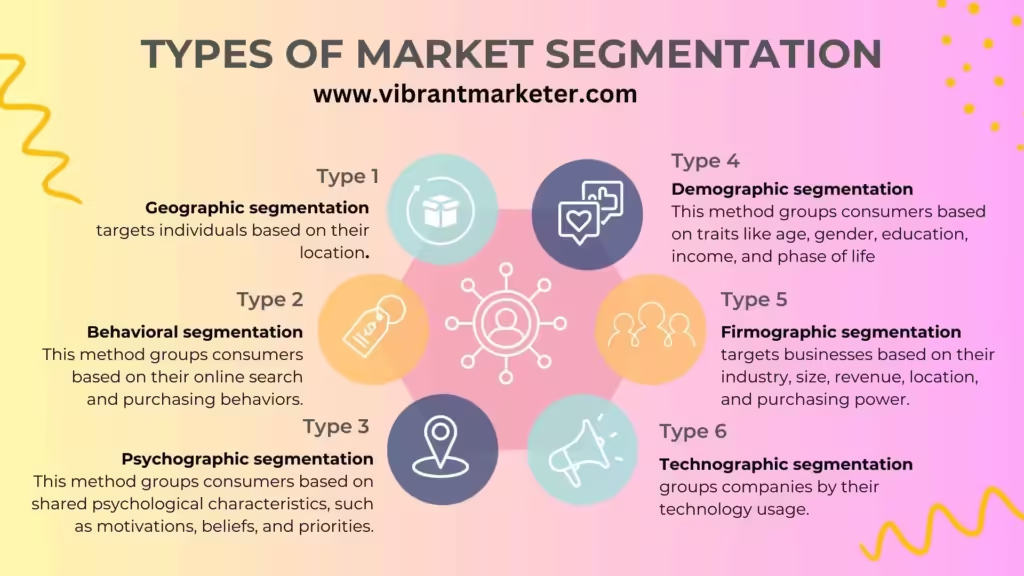
Market Segmentation: Brief Overview with Examples
Market Segmentation: Brief Overview with Examples, Types and Case Studies

Imagine you want to organize your school supplies—pencils, erasers, and crayons—into different boxes so you can easily find them when needed. Market segmentation is a similar idea for businesses, where they group their customers into smaller, specific groups (called “segments”) based on what they like or need. This helps companies make better products and offers that people will love!
Philip Kotler: “Market segmentation is the process of dividing a broad consumer or business market into sub-groups of consumers based on shared characteristics.”
David A. Aaker: “Market segmentation involves the identification of groups of customers with distinct needs and preferences in order to tailor marketing strategies to each segment effectively.”
Why Do Businesses Use Market Segmentation?

If you will try to talk to everyone in the same way, not everyone will listen to you. But when you know what a person likes, you can speak in a way that will catch their attention. This is why businesses use market segmentation. It helps them:
- Target the right people by knowing who is more likely to be interested in their products.
- Save money by focusing on customers who are more likely to buy.
- Keep customers happy by giving them exactly what they want.
According to research, companies that use market segmentation in their marketing strategies see a 76% increase in profits compared to those that don’t.
Types of Market Segmentation

- Geographic Segmentation – Where Do They Live?
This means grouping customers by where they live—like their country, city, or even the weather in their region.
Example: Nike sells winter jackets in colder areas like Canada, but focuses more on sports gear like T-shirts in hotter countries like Brazil.
2. Behavioral Segmentation – How Do They Act?
This groups customers based on their behavior, like what they buy, when they shop, or how loyal they are to a brand.
Example:
- Amazon recommends products based on what you’ve already searched for or bought.
- Netflix uses behavioral segmentation to suggest movies or shows based on your watching habits. If you binge-watch superhero movies, Netflix will suggest more action-packed content for you.
3.Psychographic Segmentation – What Do They Believe?
Psychographic segmentation groups people based on their values, interests, and lifestyle. It’s like knowing whether your friend likes sports or prefers video games.
Example:
- Apple markets the iPhone to people who value technology and stylish designs.
- Patagonia, a brand that makes outdoor clothing, attracts environmentally conscious customers who care about nature and sustainability.
4. Demographic Segmentation – Who Are They?
This is when businesses group people based on things like age, gender, income, and education. It’s like organizing your friends based on how old they are.
Example:
- Coca-Cola makes regular Coke for adults but offers Coke Zero and Diet Coke for health-conscious adults who want less sugar.
- LEGO creates simple, large-block sets for toddlers and complex ones for teenagers and adults who love building.
5. Firmographic Segmentation – What Are the Company Characteristics?
Firmographic segmentation groups businesses based on their characteristics, such as industry, company size, revenue, and location. It’s like classifying schools by whether they are public or private, or by how many students they have.
Example:
- Salesforce markets its software differently to small startups versus large corporations. Startups might need affordable and scalable solutions, while large corporations require enterprise-level features and support.
- LinkedIn tailors its advertising services to companies based on their industry and size. For instance, a large tech company might see job posting features, while a small business might be shown tools for lead generation.
6.Technographic Segmentation – What Technology Do They Use?
This type of segmentation groups people based on the technology they use, like smartphones, tablets, or computers.
Example:
- Microsoft markets its Surface Pro tablets to professionals who need portable work tools, while Samsung targets people who prefer Android devices.
Why Is Market Research Important in Segmentation?
Just like you ask your friends what they like before picking a movie for movie night, companies do market research to learn more about their customers. This helps businesses figure out:
- What products people want
- How much they’re willing to pay
- What they value the most
Data is a key part of this process. By collecting information on customers’ preferences, businesses can decide how to divide their audience and create the best products for each segment.
Benefits Of Market Segmentation

- Better Understanding of Customers
By grouping customers based on specific traits like age, location, or behavior, businesses can understand their needs and preferences more clearly. This makes it easier to create products and services that people actually want.- Case Study: Maruti Suzuki in India uses market segmentation to create different car models for different income groups. The Alto is affordable and targeted at first-time buyers, while the Ciaz is for customers looking for a more premium experience.
- Targeted Marketing
Instead of sending the same message to everyone, segmentation allows businesses to craft specific ads for each group. This leads to more effective marketing and a higher chance of making sales.- Case Study: Amazon uses behavioral segmentation to recommend products based on past purchases and searches. This type of personalized approach helps increase the satisfaction of customers and sales also .
- Improved Customer Satisfaction
When businesses tailor their products and services to meet the specific needs of each group, customers are happier and more likely to stick with the brand.- Case Study: Nike offers customized shoes based on customer preferences, appealing to individuals who want unique and personalized products.
- More Efficient Use of Resources
Businesses can focus their marketing efforts on the most promising groups, saving time and money. Instead of trying to reach everyone, they invest in the segments that are most likely to buy.- Case Study: McDonald’s uses geographic segmentation to adjust its menu based on local preferences. In India, it offers vegetarian options like the McAloo Tikki, reducing waste and increasing sales by catering to local tastes.
- Higher Profit Margins
By understanding the price sensitivity of each and every segment , businesses can adjust their pricing strategies accordingly to generate the maximum potential return.. Some groups might be willing to pay more for premium products, while others prefer budget-friendly options.- Case Study: Apple uses psychographic segmentation to market its iPhone. The iPhone appeals to customers who value sleek design and advanced technology, allowing Apple to charge premium prices and maintain high profit margins.
- Discovering New Market Opportunities
Market segmentation can help businesses identify underserved groups or new markets. This creates opportunities to develop new products or enter new regions.- Case Study: Hindustan Unilever identified the growing demand for natural and eco-friendly products in India and introduced the ‘Love Beauty and Planet’ brand, focusing on environmentally conscious consumers.
- Stronger Brand Loyalty
When customers feel like a brand “gets them” and offers products that align with their values and needs, they are more likely to stay loyal.- Case Study: Patagonia, an outdoor clothing brand, targets environmentally conscious consumers through psychographic segmentation. Their commitment to sustainability has created a loyal customer base that values eco-friendly products.
- Increased Competitiveness
By focusing on specific segments, companies can create unique selling propositions (USPs) that set them apart from competitors.- Case Study: Tesla uses both psychographic and behavioral segmentation to target the environmentally conscious consumers who value innovation and sustainability which later on become their strength also . This approach has helped Tesla stand out in the crowded automobile market.
Ethical Considerations in Market Segmentation
It’s important for businesses to use market segmentation in a way that respects people’s privacy and doesn’t harm anyone. The key factors that the companies should think about :
- Privacy: Companies must make sure they handle customers’ data with care and don’t misuse it. It should be mandatory that the companies should ask first before using the personal information.
- Avoiding Harmful Stereotypes: Businesses should avoid making unfair assumptions about people based on their segment. For example, they shouldn’t stereotype people by their gender or race.
- Vulnerable Groups: Companies should be careful when marketing to groups that might be vulnerable, like children or people with certain health conditions. For example, fast-food chains need to be mindful of how they advertise sugary products to kids.
Future Trends in Market Segmentation
As technology keeps advancing, businesses are using even smarter tools to understand their customers. Here are two big trends:
- Artificial Intelligence (AI): AI helps companies analyze customer behavior in real time. It can predict what customers might want to buy next and tailor offers just for them.
- Example: Amazon uses AI to recommend products you might like based on your previous shopping history.
- Big Data: Companies are now using huge amounts of data (big data) to find patterns in how people shop, what they search for, and when they’re likely to buy.
- Example: Netflix analyzes billions of data points to suggest shows and movies that match your viewing habits.
Fun Activity – Create Your Own Market Segmentation!
Let’s imagine you own an ice cream shop. Your customers are very different, so you need to create segments. Here’s how you can do it:
- Demographic Segment: Kids who love chocolate flavors and adults who prefer healthier options.
- Geographic Segment: People who live in hot cities might want cold ice cream, while people in cooler places might prefer ice cream with warm toppings.
- Psychographic Segment: Some customers care about trying new, exotic flavors, while others want classic, simple ice cream.
What flavors would you create for each group? How would you tell them about it?
Conclusion: What is Market Segmentation with Example
Segmentation helps businesses save money, reach more people, and keep customers happy. As technology improves, segmentation will keep getting smarter, helping businesses grow in new and exciting ways!
